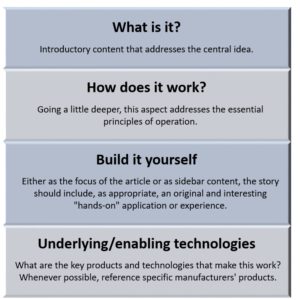Welcome! We’re delighted that you have an interest in contributing to the Technica Curiosa experience. This note outlines the essential guidelines that will ensure the success of our collaboration.
We offer a wide and flexible canvas for telling your story. Not every article will exactly fit the model described here, and that’s okay. We present the following to help guide your writing.
Most importantly, we seek to provide a service to our readers by delivering compelling content that addresses the practical sciences, as well as interesting technologies, how they work, and what difference they will make in our readers’ personal and professional lives. Aside from hands-on pieces, stories might simply bring new concepts and ideas to light—stories that are inspiring or illuminating in their own right. You’ll also see that we are big fans of the history of technology, as this not only contributes important perspectives on today’s technologies, but can also highlight the deep legacies of our titles. We also feature articles from classic issues, and ask readers, “How would you do this today?”
Generally speaking, we are always interested in long and short articles and essays (1,000 to 3,000 words or more) that cover new and emerging technologies with practical applications across the board, including electronics, mechanics, computing, automotive, aerospace, robotics, astronomy/astrophysics, metamaterials, and other areas.
 In addition to the general guidelines described herein, where appropriate to the subject matter, content should also address the four areas shown in the figure at left. This approach enables our titles to address our diverse audiences, who may have different objectives with respect to the content, and span the tech curious/inventor to the professional scientist/engineer to the business development/tech transfer executive.
In addition to the general guidelines described herein, where appropriate to the subject matter, content should also address the four areas shown in the figure at left. This approach enables our titles to address our diverse audiences, who may have different objectives with respect to the content, and span the tech curious/inventor to the professional scientist/engineer to the business development/tech transfer executive.
We seek submissions that are, above all else, well-written: that is, distinguished by good story-telling, human interest, anecdotes, analogies, and humor, among other traits of good writing. In short, we want our readers to be irresistibly pulled into your story!
In your proposed article query or abstract, please identify the targeted channel (Popular Electronics, Mechanix Illustrated, Internet of Things, Popular Astronomy, etc.), and let us know what makes the subject matter new, different, better, interesting, more efficient.
Tone and style should be instructive without being academic; professional, yet accessible; technical in nature, but always with practical takeaways. Articles should include in-depth coverage of the inner workings of the subject matter (principles of operation), a discussion of the enabling technologies, as well as tips, techniques, and sources for practical application (DIY). Relevant sidebars, interesting rabbit holes, and synergistic tie-ins with other content on the site are always welcome, particularly as we build a critical mass of content that we can reference from other articles.
We also ask our authors to deliver as complete a package as possible. Technica Curiosa’s art department always welcomes illustrations, photographs, schematics, BOMs, video, and diagrams/sketches pertaining to stories submitted, and sufficient to serve as a complete reference for our illustrators.
A story should come with a headline for each story element and captions for photos and/or illustrations. The complete package should also include background material and documentation used by the author, as well as a brief author bio and contact information (identifying such information requested for publication). Material is subject to editing for length, style, and format.
Please address all submissions to [email protected], and include in the subject line the word “Editorial.”
Thank you for participating in what we sincerely hope will be a rewarding experience for you and your organization!






